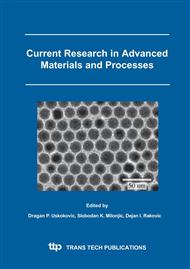p.321
p.327
p.333
p.339
p.345
p.351
p.357
p.363
p.369
Reduction of NiO-WO3 Oxide Mixtures Synthesized by Gel-Combustion Technique: A Route to Ni-W Alloys
Abstract:
The mixtures NiO-WO3 were synthesized by the combustion of gels obtained by drying common solutions of nickel nitrate, polytungstic acid and citric acid. The X-ray diffractograms of oxide mixtures confirmed mutual interaction of oxides during synthesis leading to a new phase, NiWO4. The reduction of oxide mixtures in hydrogen atmosphere was investigated thermogravimetrically. The temperature of reduction of the oxide mixture lies between the temperatures of reduction of pure oxides and monotonously increases with the increase in WO3 mole fraction; however, the reduction itself is a multi-step process, preferably in the composition region rich in NiO. The X-ray diffractometry of metallic residues evidenced Ni-W alloys and tungsten excess to be the reduction products.
Info:
Periodical:
Pages:
345-350
Citation:
Online since:
September 2005
Authors:
Price:
Сopyright:
© 2005 Trans Tech Publications Ltd. All Rights Reserved
Share:
Citation:


